Digital Poster
New Ideas in Coils II: Flexibility, Interfaces & Multi-Nuclei Designs
Joint Annual Meeting ISMRM-ESMRMB & ISMRT 31st Annual Meeting • 07-12 May 2022 • London, UK

| Computer # | ||||
|---|---|---|---|---|
2253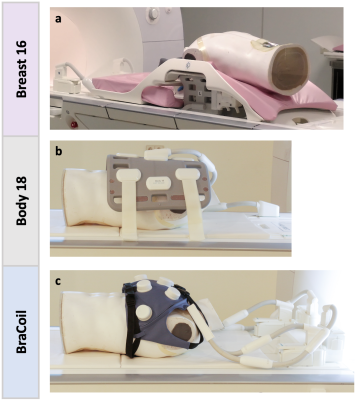 |
66 | BraCoil – preliminary performance evaluation of a wearable breast coil array for 3 T MR mammography Video Permission Withheld
Lena Nohava1,2, Michael Obermann1, Roberta Frass-Kriegl1, Karyna Isaieva2, Claire Dessale3, Jacques Felblinger2,3, and Elmar Laistler1
1High Field MR Center, Center for Medical Physics and Biomedical Engineering, Medical University of Vienna, Vienna, Austria, 2IADI, Inserm, Université de Lorraine, Nancy, France, 3CHRU-Nancy, Inserm, Université de Lorraine, CIC, Innovation Technologique, Nancy, France
A dedicated radio frequency coil design for MR mammography needs to optimize sensitivity, reduce scan time, and improve patient comfort to ultimately facilitate diagnosis. We investigate signal-to-noise ratio and parallel imaging performance differences between widely used commercial 16-/18-channel receive coils for breast MRI at 3 T in prone and supine position and an in-house developed 28-channel wearable coil array (“BraCoil”). An SNR gain of up to a factor of 6 with BraCoil was found in this phantom study.
|
||
2254 |
67 | Constant-Tissue Model for Comparison of Supine and Prone Breast Coil SNR
Jessica Ann McKay-Nault1, Catherine J Moran1, Jeremiah Hess2, Jana Vincent3, Fraser Robb3, Bruce L Daniel1, and Brian A Hargreaves1
1Department of Radiology, Stanford University, Stanford, CA, United States, 2Department of Bioengineering, Stanford University, Stanford, CA, United States, 3GE Healthcare, Aurora, OH, United States
Recent work has developed supine breast imaging for improved correlation with surgery and comfort but will likely require breast-specific coils to maximize the SNR. Comparing prone and supine SNR can be difficult due to substantial deformation between the positions and heterogeneity of the patient population. We measured SNR in a constant-tissue model to reduce dependence on tissue heterogeneity and provide an overall SNR across the volume of interest. We compared SNR of a novel 60-channel supine coil and a standard prone coil. In the cosntant-tissue images, the supine 60-channel coil increased SNR by 33%, 78% and 80% across 3 volunteers.
|
||
2255 |
68 | Construction and characterisation of a 7 Tesla flexible body coil with 10 transmit dipoles and 30 receive loops
Konstantinos Papoutsis1, Jérémie Clément1, Stephen E Ogier1, Joseph V Hajnal1,2, Vicky Goh3, Gary J R Cook3, and Özlem Ipek1
1Biomedical Engineering Department, School of Biomedical Engineering and Imaging Sciences, King's College London, London, United Kingdom, 2Centre for the Developing Brain, School of Biomedical Engineering and Imaging Sciences, King's College London, London, United Kingdom, 3Department of Cancer Imaging, School of Biomedical Engineering and Imaging Sciences, King's College London, London, United Kingdom
We present the first continuous 30-channel loop receive coil array combined with the 10-channel dipole parallel-transmit array for 7 Tesla body imaging. Array comprises a flexible anterior part with 6 dipoles and 18 loops, with 35cm longitudinal coverage along with a hard plastic posterior part containing 4 dipoles and 12 loops. Special features were added to help patient comfort and overcome cabling limitations. Simulations with computational human model show adequate B1+ coverage in areas of interest such as the prostate. Phantom images were taken showing promising results. Further development will follow, and human imaging is planned in the near future.
|
||
2256 |
69 | Optimization and Analysis of Shielded Loop Resonators towards Modular Coil Arrays
Manvitha Sreereddy1, Michael Bock1, and Ali Caglar Özen1
1Dept. Radiology, Medical Physics, Medical Center - University of Freiburg, Freiburg, Germany
Light-weight and flexible RF coil arrays are needed to obtain high SNR which is translated into shorter scan times and to increase patient compliance. Transmission line resonators or shielded loop resonators (SLR) are insensitive to the changes in geometry and form, since the tuning is determined by the length of the transmission line. In this study, we propose two parameters and a test setup to evaluate coaxial cables and relate this to the SLR performance. Modularity is demonstrated on facial coil that can be attached to the face masks.
|
||
2257 |
70 | Pycoilib: a free and pedagogical tool for the calculation of self/mutual inductance of coils of arbitrary geometry in python
Aimé Labbé1 and Marie Poirier-Quinot1
1Université Paris-Saclay, CEA, CNRS, Inserm, Laboratoire d'Imagerie Biomédicale Multimodale Paris Saclay, Orsay, France
We introduce pycoilib, a python library developed for the computation of self and mutual inductance of coils. The library allows the user to design coils by dividing their three-dimensional geometry into collections of lines, arcs and circles, and by specifying the geometry of the cross-section of the coil wire. In a case study, the self-inductance of a deformable coil is computed as a function of its configuration. Pycoilib has the potential to become a valuable tool for prototyping, as well as teaching.
|
||
2258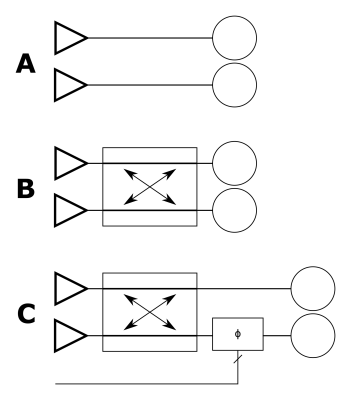 |
71 | Improving the Flexibility of RF Power-Sharing Networks with High-Power Phase Shifters
Stephen E. Ogier1, Shaihan J. Malik1, and Joseph V. Hajnal1,2
1Biomedical Engineering Department, School of Biomedical Engineering and Imaging Sciences, King's College London, London, United Kingdom, 2Centre for the Developing Brain, School of Biomedical Engineering and Imaging Sciences, King's College London, London, United Kingdom
A typical parallel transmit system has an equal number of RF power amplifiers individually connected to an equal number of coil elements. When performing B1+ shimming, the maximum B1+ available is limited by single channel amplifier performance. RF networks which allow for power to be shared between transmit channels have been proposed as a way to overcome this limitation, but fixed networks only offer performance gains over limited ranges of relative phases between channels. Adding a high-power phase shifter between a power-sharing network and coil element can combat this, even with only a few bits of resolution.
|
||
2259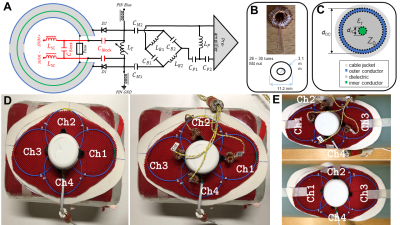 |
72 | A 4-channel flexible array with integrated B0 shimming for 3 T
Bernhard Gruber1,2, Michael Obermann1, Lena Nohava1, Maxim Zaitsev1, Lawrence L. Wald3, Jason P. Stockmann3, and Elmar Laistler1
1High Field MR Center, Center for Medical Physics and Biomedical Engineering, Medical University of Vienna, Vienna, Austria, 2A.A. Martinos Center for Biomedical Imaging, Massachusetts General Hospital/Harvard Medical School, Charlestown, MA, United States, 3A.A. Martinos Center for Biomedical Imaging, Massachusetts General Hospital, Harvard Medical School, Charlestown, MA, United States
Integrated B0 shimming capability with RF coil arrays has already shown advantages in dense configurations. For highly flexible arrays this approach is a challenge due to the bulky RF chokes required to bypass the segmenting capacitors of classical loop coils. In this work we present a flexible 4-channel coaxial coil array module with integrated B0 shimming requiring only two RF chokes per shim channel and thereby demonstrate the feasibility of integrating B0 shim capability into flexible arrays.
|
||
2260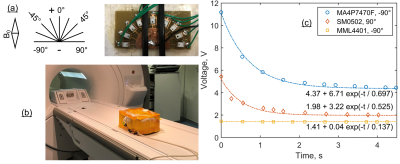 |
73 | Studying the influence of cryogenic cooling and B0 alignment on Si PIN diode operation in active decoupling circuits
Wenjun Wang1, Vitaliy Zhurbenko1, Juan Diego Sánchez Heredia2, and Jan Henrik Ardenkjær Larsen2
1Department of Electrical Engineering, Technical University of Denmark, Kongens Lyngby, Denmark, 2Department of Health Technology, Technical University of Denmark, Kongens Lyngby, Denmark
Si diodes can require elevated forward bias voltage to achieve sufficient forward bias current when they are placed in a strong static magnetic field B0 at cryogenic temperatures. This may disrupt active decoupling circuit operation in cryogenic MRI coils. Diodes may still operate if aligned in a certain way with the B0 field, which is studied in this work.
|
||
2261 |
74 | Flexible Receive Array of Parallel-Resonance High-Impedance Coaxial Coils for 13C Imaging Video Permission Withheld
Vitaliy Zhurbenko1, Juan Diego Sanchez Heredia1, Wenjun Wang1, and Jan Henrik Ardenkjær-Larsen1
1Techical University of Denmark, Kgs. Lyngby, Denmark
Self-resonant coils are well suitable for flexible array design. The size of such coils is dictated by the RF signal wavelength, which makes the design challenging at low frequencies. In this work, 13C tuning is achieved by combining distributed and lumped capacitance with the self-inductance of an RG-178 coaxial cable. A 1H trap is moved from the coil to the board of the preamplifier for better coil flexibility. The active 13C decoupling circuit is compact and broadband. The approach is used to develop a flexible 8-channel receive array of parallel-resonance coils for 13C-imaging. The array elements exhibit low noise correlation.
|
||
2262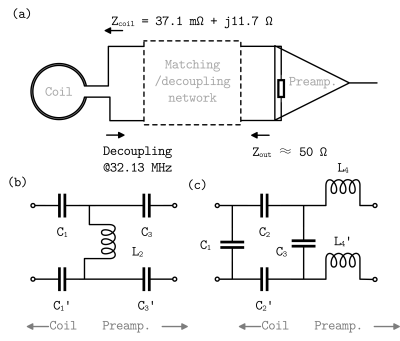 |
75 | Effect of Matching Network Losses on preamplifier decoupling circuit topologies at room and cryogenic temperature for 3 T 13C applications
Wenjun Wang1, Vitaliy Zhurbenko1, Juan Diego Sánchez Heredia2, and Jan Henrik Ardenkjær Larsen2
1Department of Electrical Engineering, Technical University of Denmark, Kongens Lyngby, Denmark, 2Department of Health Technology, Technical University of Denmark, Kongens Lyngby, Denmark The SNR performances of a three- and a four-element matching circuit topologies are compared for the case of 3 T 13C imaging. The benefit to SNR of cryogenic cooling is also compared against the choice of matching networks. Results show that while cryogenic cooling can improve the output SNR by 2–3 dB, a less lossy matching network design can improve the SNR performance by 7–8 dB. The importance of matching network design ought not to be dismissed. |
||
2263 |
76 | Combination of screen printed process with electrodeposition steps to drastically improve flexible MRI coils sensitivity
Camila Pereira Sousa1,2, Jean-Lynce Gnanago1, Valernst Gilmus1, Tony Gerges1, Philippe Lombard1, Michel Cabrera1, Hugo Dorez2, and Simon August Lambert1
1Université de Lyon, INSA Lyon, Université Claude Bernard Lyon 1, Ecole Centrale de Lyon, CNRS, Ampère UMR5005, Villeurbanne, France, 2Hawkcell, Marcy l'Etoile, France
In the last few years, there has been an increasing interest from the scientific community in the fabrication of flexible coils. Several methods can be used for the manufacture of flexible coil, mainly screen-printed coils on flexible substrates. In this work, three different screen printing coils with different layers of silver ink were manufactured and their quality factors were measured on bench. A MR-coil combining screen-printed process with electrodeposition step was also built. The additional manufacture step allowed improving drastically Q factor of our screen-printed coil with more than one order of magnitude while maintaining good flexibility of the substrate.
|
||
2264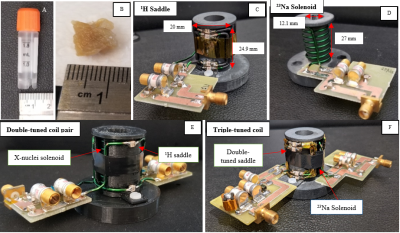 |
77 | RF Coils for Evaluation of Duchenne Muscular Dystrophy Biomarkers at 4.7 T
Edith Valle1, Travis Carrell2, Peter P. Nghiem3, Steven M. Wright1,2, and Mary P. McDougall1,2
1Electrical and Computer Engineering, Texas A&M University, College Station, TX, United States, 2Biomedical Engineering, Texas A&M University, College Station, TX, United States, 3Veterinary Integrative Biosciences, Texas A&M University, College Station, TX, United States
Duchenne muscular dystrophy (DMD) is a debilitating genetic muscle disorder. To study and characterize this disease efficiently, our group has developed a set of custom single-tuned and multi-tuned coils. We have acquired 1H, 23Na and 31P data from 20 healthy and diseased samples. Some of the studied biomarkers have shown clear distinctions between healthy and diseased samples.
|
||
The International Society for Magnetic Resonance in Medicine is accredited by the Accreditation Council for Continuing Medical Education to provide continuing medical education for physicians.